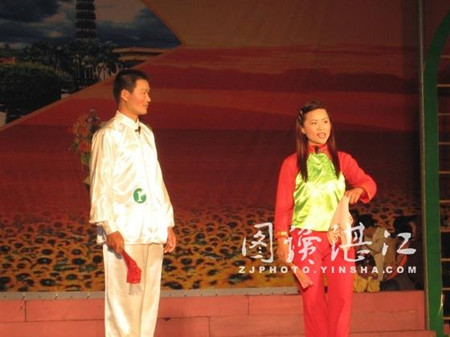Home> Arts and Traditions
Leizhou song rings out for 500 years
Before written history, Chinese tradition and culture were passed from generation to generation by word of mouth, spreading from family, to community, to region, via storytelling or folk songs.
Folk songs date back thousands of years in China, there simple messages, themes and structure still striking a chord with people today.
Leizhou Peninsula on the southwestern tip of Guangdong province, is steeped in history and folk culture, not the least of which being its Leizhou song which dates back some 500 years.
The vast array of melodies and harmonic crooning cover a deep back catalog of subjects all poignant and telling about the trials, tribulation, love and loss people experience in Leizhou so many years back. Subjects such as family, birth, death, love, courtship, romance, and farming are all dealt with extensively in the gamut, all sung in the native Leizhou dialect.
 |
|
A Leizhou folk song duet is performed on stage. [Photo/zjphoto.yinsha.com] |
For the area's 5 million inhabitants, Leizhou song is seen as a "living" songbook, binding the people together with a common heritage and story.
Many Leizhou folk songs are improvised, giving singers greater freedom but providing a bigger challenge. One thing that is never missing is the 17 different rhymes which are used to provide a basic structure to the performance.
One of the most famous styles of Leizhou song is known as guniang or "girl song". Voiced by female singers, the songs take the form of call and response, with one singer asking questions which are quickly followed by the other answering in harmony. Girl song often references literature, geography and folk customs.
Despite its long history, the popularity of Leizhou song has never waned in the public consciousness and even spurred the creation of Leizhou Opera, which has become another well-loved folk tradition. Both have been recognized as cultural legacies under the protection of the state government.

 Print
Print Mail
Mail 5G construction supports Zhanjiang's high-quality development
5G construction supports Zhanjiang's high-quality development
 Acting mayor inspects project construction in Xuwen, Leizhou
Acting mayor inspects project construction in Xuwen, Leizhou Zhanjiang island an "egret paradise"
Zhanjiang island an "egret paradise"  Dancing egrets add vitality to Xiashan
Dancing egrets add vitality to Xiashan